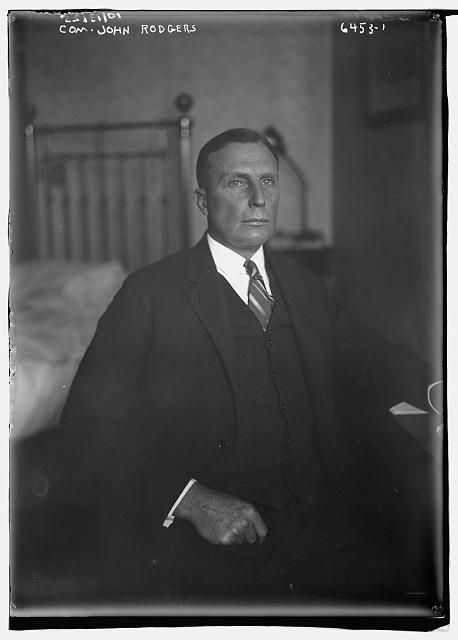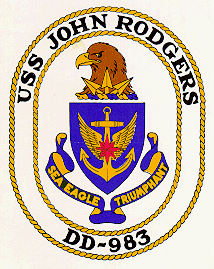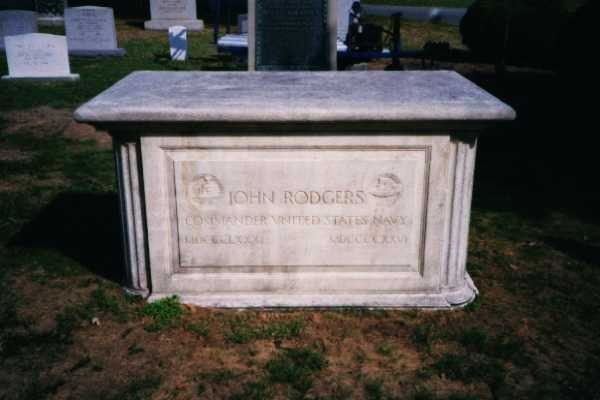John Rodgers was a member of one of the most famous families in United States Navy history.
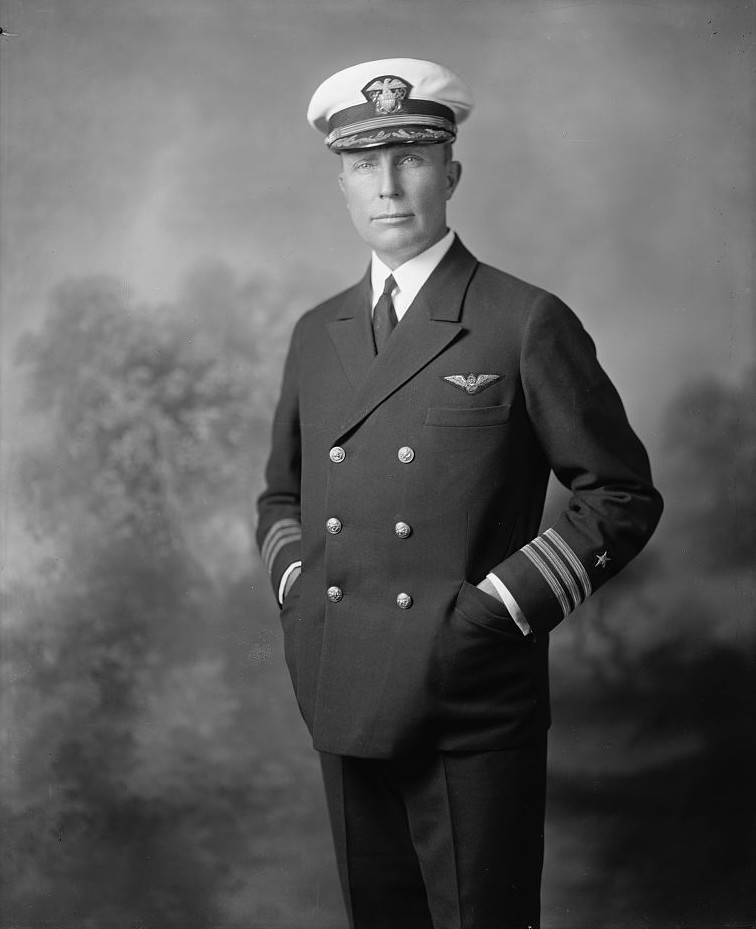
He was a pioneer in Naval Aviation and eventually became Chief of the Navy Aeronautical Bureau, a position he held at the time of death in a plane crash in the Delaware River near the Philadelphia Navy Yard.
He graduated from the United States Naval Academy in 1903 and was assigned from sea to air duty in 1911, when he attended the flying school operated by the Wright Brothers. He was the second Naval Officer is history to qualify as a Naval Aviator. He established the Naval Air Station at San Diego, California.
During World War I, he commanded Submarine Division 1 of the Atlantic Fleet.
From 1798 until his death on August 26, 1926, there had been members of his family with the name “John Rodgers” actively serving with the United States Navy.
Rodgers, John, January 15, 1881 – August 27, 1926), naval officer and aviator, son of Rear Admiral John Augustus and Elizabeth (Chambers) Rodgers, was born in Washington, D. C., although the Rodgers’ home was at Havre de Grace, Maryland.
He was of a family long distinguished in the annals of the United States Navy, being a great-grandson of John Rodgers [1773-1838], who was one of the first of the name to attain renown as an American naval officer. Sarah (Perry) Rodgers, daughter of Matthew C. Perry, was his grandmother.
John attended the Lawrenceville School, Lawrenceville, New Jersey, served on the Columbia during the Spanish-American War, and in 1899 entered the U. S. Naval Academy, from which he graduated in 1903. During the ensuing years he was promoted through the various grades and was made Commander, November 4, 1920.
Becoming interested in aviation, he attended the Wright Flying School, Dayton, Ohio, and was the second naval officer to be licensed as an aviator. During the World War he was in the submarine service and on North Sea mine barrage duty. Returning later to aviation, from 1922 to 1925 he was commander of the Naval Air Station, Pearl Harbor, Hawaii. In the latter part of 1925, the resourcefulness and heroism he displayed as commander of the San Francisco-Hawaiian flight brought him wide acclaim. On August 31, two navy seaplanes took off from near San Francisco. One of these was forced down after covering about 300 miles. The second, which contained Commander Rodgers and four others, was obliged to descend on September 1, when 400 miles from its destination, because of lack of fuel. For nine days it was tossed about on the deep, its occupants never losing courage. They subsisted on the scanty emergency rations which they had with them, and on sea water which Rodgers distilled in a still given him by his mother. From the fabric of a wing he also fashioned a sail. On September 10 they sighted Kauai and were picked up by a submarine when about fifteen miles from that island. The following day Rodgers wrote a concise and vivid account of the adventure, which was published in United States papers. In recognition of his sterling qualities as an aviator and his ability as a seaman and navigator, he was appointed assistant chief of the Bureau of Naval Aeronautics.
Office work at Washington was not suited to his taste or temperament, however, and on August 16, 1926, he was placed in command of a new scouting seaplane squadron, created for experimental purposes, at San Diego, Califronia. Eleven days later he started in a land plane from the Naval Air Station, Washington, for Philadelphia, where he was to inspect some new planes at the aircraft factory of the Navy Yard. When nearing the city, his plane fell from a comparatively low height into the shallow water of the Delaware, and Rodgers was pinioned in the cockpit. After an hour of intense suffering he was released and taken to the Naval Hospital, where he died. At the time of his death he was listed for promotion to captain. His wife, from whom he was divorced in 1924, was Ethel Greiner Rodgers.
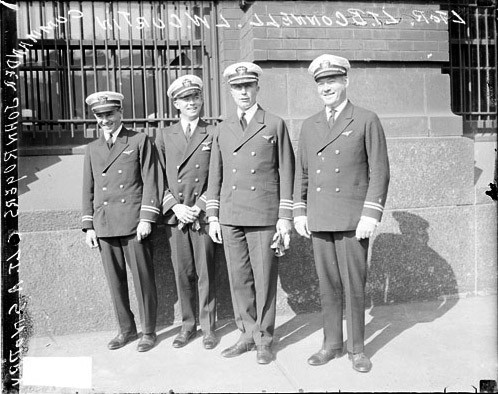
USS JOHN RODGERS (DD 983)
COAT OF ARMS
The official crest of JOHN RODGERS symbolizes the service of three members of a prominent Navy family. The anchor represents the service of Commodore John Rodgers, who acted as President of the Board of Naval Commissioners, following the War of 1812, until 1837. His son, Rear Admiral John Rodgers, led exploring expeditions in Chinese waters and through the Bering Strait in 1855; the compass rose is symbolic of his service. Commander John Rodgers II, great-grandson of Commodore Rodgers, was a pioneer of Naval Aviation, and his service is alluded to by the wings.
The sea eagle, a sharp-eyed, marine bird-of-prey, represents the ship’s primary mission of detection and tracking, with the addition of incredibly deadly striking ability. The three arrowheads refer to the multi-mission capabilities of the SPRUANCE Class destroyer, as well as the Naval service of the father, son, and great-grandson for whom the ship is named.
RODGERS, JOHN
- COMMANDER US NAVY
- VETERAN SERVICE DATES: Unknown
- DATE OF DEATH: 08/27/1926
- DATE OF INTERMENT: Unknown
- BURIED AT: SECTION W.E SITE 130
- ARLINGTON NATIONAL CEMETERY
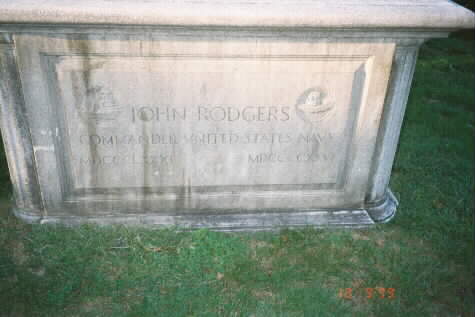
Michael Robert Patterson was born in Arlington and is the son of a former officer of the US Army. So it was no wonder that sooner or later his interests drew him to American history and especially to American military history. Many of his articles can be found on renowned portals like the New York Times, Washingtonpost or Wikipedia.
Reviewed by: Michael Howard

